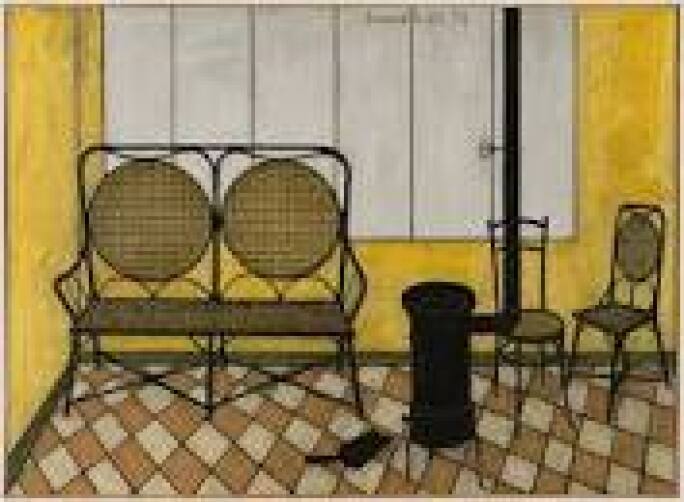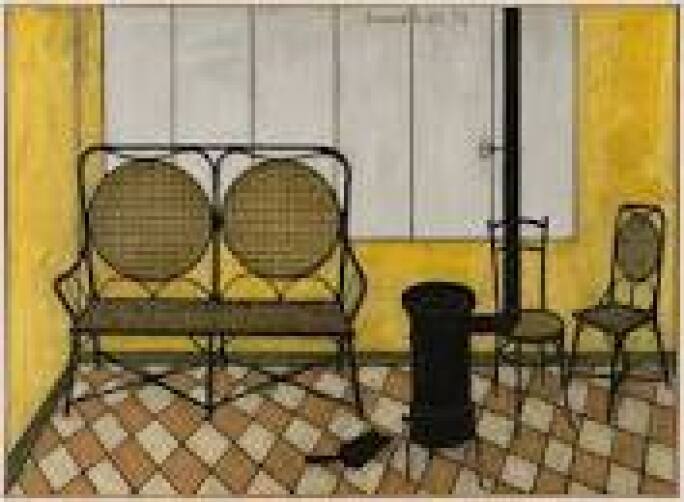Bernard Buffet, a master of post-war figurative art in France, dedicated his career to representational work. His paintings, characterised by expressive black lines and sharped brushstrokes, were immensely loved by the public. In the 1970s, he was regarded by pop artist Andy Warhol as the only recognized French contemporary artist of the time. Buffet was very popular even in Asia. In 1973, the world’s first museum for Bernard Buffet was established in Shizuoka, Japan, displaying thousands of Buffet's works, which kicked off a wave of ‘Buffet mania’ in Asia. In 1974, when he was 46, he was named the youngest-ever member of the Académie des Beaux-Arts. Intérieur aux deux fauteuils (Lot 1035), painted fourteen years later, represents the artist’s mature period in the 1980s. The work features Buffet’s trademark incisive black lines, but the colouring and composition are full of confidence, with the open and calm ambience of a master’s late work.Interior scenes are a frequent theme in Western art history, and Intérieur aux deux fauteuils shows Buffet’s experimental yet skillful approach to depicting a classic subject in a new way. Paintings of interiors first emerged in the Renaissance, but by the twentieth century, this genre was no longer limited to extolling the poetry in everyday life. Modern artists consciously elevated scenes of furnishings to realist allegories that allowed them to express their emotions through the depicted objects, reflecting their personalities and ambitions. The bright yellow stripes on the chairs contrast nicely with the saturated gold of the wall and the ochre of the floor. In this distinctive colour scheme, the tones are consistent yet complementary. Dining chairs are placed to the right and left, and their slightly different sizes disrupt the balance of the painting. Buffet brilliantly directs the visual focus of the work to the white sculpture in the center. The sculpture’s rightward gaze magically dissolves the spatial imbalance between the left and right sides of the painting. This sculpture is the center of gravity for the work, allowing the space to extend to both sides. With just a few items, Buffet creates a calm and comfortable living space. The signature and date in the top corners have a lot of personality, almost blending into the pattern of the wallpaper and cleverly balancing the composition. With his brush, Buffet smooths over any areas of disharmony. The white sculpture in the painting represents portraiture, one of Buffet’s favored genres, but it is also a still life sketch of a sculpture and an interior scene from everyday life. He seamlessly fuses his prowess with these various genres into a single image, and his treatment of spaces and themes shows that he is a true master of the medium.

To an extent, Buffet’s expression of emotion through objects achieves the same goal as Eastern art’s tactful, reserved approach, but in a different way. In contrast to his ongoing interrogations of the post-war mentality back in the 1950s, Buffet’s Intérieur aux deux fauteuils, painted in his sixties, was inspired by everyday life, but also reveals his reflections on larger themes such as an individual artist’s place in history or art history. The colours, composition, and subject matter are gently imbued with a clear, sunny aura. In 1954, four years after Buffet painted his first interior scene, entitled Intérieur (1950), the work was added to the permanent collection of the Centre Pompidou in Paris. At the age of just 26, he had attracted the attention of a national museum with a work on this subject, so interior scenes are undeniably important for his creative trajectory. Buffet’s paintings of circus clowns, flower still-life, landscapes, and portraits frequently appear on the market, but this interior scene is a true rarity. Intérieur aux deux fauteuils was an important look back for the sixty-year-old Buffet, reflecting his greater wisdom more than thirty years later.
Intérieur aux deux fauteuils was originally purchased from the gallery of legendary art dealer Maurice Garnier, someone Buffet had known for five decades. Since the late 1970s, the gallery has worked tirelessly to bring Buffet’s works to the international stage, facilitating many exhibitions at important institutions, including the Odakyu Museum in Tokyo (1987), the Kaohsiung Museum of Fine Arts in Kaohsiung (1996), the Seedamm Cultural Center in Zurich (1983), and the Pouchkine Museum in Moscow (1991). Intérieur aux deux fauteuils was first acquired from a private Japanese collector in the 1990s and has been in private hands for nearly thirty years, as a testament of the increasing interest in Buffet’s work among Asian collectors since the 1970s.
法國戰後具象藝術的代表大師貝爾納.布菲一生堅持創作具象藝術,畫作突出黑色綫條及棱角,極具表現力與辨識度,深得公眾的喜愛。在70年代更被波普藝術家安迪•沃荷視之爲法國當代唯一的藝術家。在1973年,更在日本靜岡成立了世界第一座布菲美術館, 長期展示上千張布菲的作品。可見自1980開始,日本對布菲的鍾情更輻射性影響亞洲,捲起一股「布菲熱」 。1974年,布菲以46歲之齡入選為最年輕的法蘭西學院美術學院院士。14年後完成《室內的一對扶手椅》(拍品編號1035),可謂藝術家1980年代集大成之成熟時期,作品不單充分表現藝術家一貫標誌性的尖銳黑色線條處理,在用色、構圖方面亦見自信、大方,整體氛圍流露出此時期特有的豁達、從容。「室內畫」為西方藝術史上歷久常新的題材,《室內的一對扶手椅》展示了藝術家能從經典題材表現嶄新感悟的高度企圖心和能耐。「室內畫」最早出現於文藝復興,進入20世紀,此類型不再局限於歌頌日常生活的詩意,現代藝術家有意將其由家具景觀昇華為一種借物言情述志的寫實寓言,洋溢藝術家的人格志氣。餐椅的亮黃直紋、與牆身的飽和金黃、及地板的土黃相映成趣,搭配鮮明,色調一致又互相呼應。兩張餐椅對倒般放置在畫面的左和右,一左一右的餐椅大小不一,本應大幅破壞畫面平衡。布菲高明地引導視覺焦點到畫面中央的白色雕塑,其目光投向畫面右方,神奇地化解了左右兩邊不對等的空間,此雕塑更奠定了畫面的重心,容許空間往兩邊延展,布菲僅以寥寥數件生活陳設便塑造了一個悠然自得的生活空間。個性十足的簽年與年代款識,巧妙地化身為牆紙花紋的一部分,平衡畫面構圖。曾經處處的不和諧一一被布菲的妙筆布局消弭於無形。畫中的白色雕塑既是布菲駕輕就熟的肖象主題,亦是一個雕塑靜物寫生,同時亦是日常生活室內場景主題,可見布菲能夠輕易駕馭各種題材又不費力地將其融為一體,空間、主題的處理手法盡顯布菲的大師功架。

布菲以物喻情的藝術本質與東方藝術含蓄婉轉的風格在某程度上實是殊途同歸。有別於1950年代探討刻下人類戰後心理狀態,花甲之年的布菲在《室內的一對扶手椅》從日常生活出發,琢磨至個體置身歷史敍述、藝術史等更宏觀的反思;色調、格局、選材淡淡滲透着藝一種雲淡風輕的覺悟。布菲早期室內景觀作品《室內》早於成畫後四年內於1954年進入巴黎龐比度藝術中心永久收藏,藝術家當時年僅26歲便以此題材之作品受國家級美術館青睞,「室內畫」此主題於藝術家創作脈絡上的重要性不言而喻。市場上常見布菲馬戲團小丑、花卉靜物、風景、肖象主題之作品,是次難得釋出室內景觀作品,難能可貴。《室內的一對扶手椅》更是布菲年屆六十時對此重要主題的回顧,創作成果著實反映出他三十多年後更上一層樓的哲思領悟。
《室內的一對扶手椅》最初出自與布菲與相知相識五十載的傳奇畫商莫里斯.賈尼耶畫廊。此畫廊從1970年代後期起不遺餘力地將布菲的作品帶到國際舞台,促成藝術家多個重要美術館展覽,如:東京小田急美術館(The Odakyu Museum, Tokyo, 1987)、高雄市立美術館 (1996)、蘇黎世希丹文中心(Seedamm Cultural Center, Zurich, 1983)、莫斯科普希金美術館(Pouchkine Museum, Moscow, 1991)等。《室內的一對扶手椅》約1990年代由日本私人藏家購藏,珍藏近三十載,本作見證亞洲藏家自1970年代起對布菲作品日益增長的熱情。

